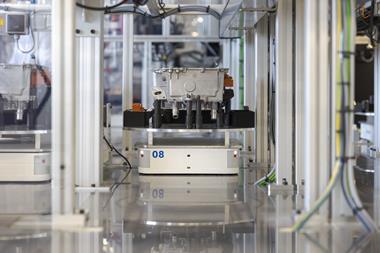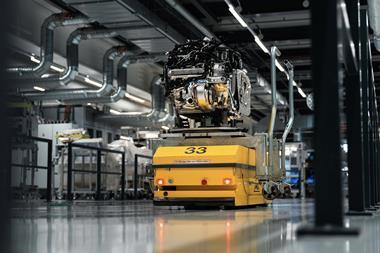Mike Farish takes a close-up look at how devolved management helps Ford operate highly flexible production on its powertrain lines
Opened ten years ago at a cost of £325m, the Ford Dagenham Diesel Centre (DDC) comprises a climate-controlled production hall with 44,530 square metres of floor space for diesel engines plus associated office accommodation for co-located design staff.
Jo Payne, diesel new programmes manager with Ford’s global engineering manufacturing group explains that the building itself and the people, procedures and equipment it houses are all directed towards the single overriding objective of building engines in a way that constitutes a benchmark for efficiency and flexibility.
 Currently, two families of engines are produced at the DDC. The first of these are the 1.5L and 1.6L versions of the TDCi engine used in the Fiesta, B-Max, Focus, C-Max, Mondeo, S-Max and Galaxy vehicles. Originally designed by Peugeot, Ford designates this engine the DV or alternatively as the Tiger, reflecting the company’s policy of giving the engine lines at Dagenham a big cat name. The engine is also used in Mazda and Volvo vehicles. The second engine family – the Lion – comprises the 2.7L and 3.0L V6 engines also used by Jaguar Land Rover and PSA.
Currently, two families of engines are produced at the DDC. The first of these are the 1.5L and 1.6L versions of the TDCi engine used in the Fiesta, B-Max, Focus, C-Max, Mondeo, S-Max and Galaxy vehicles. Originally designed by Peugeot, Ford designates this engine the DV or alternatively as the Tiger, reflecting the company’s policy of giving the engine lines at Dagenham a big cat name. The engine is also used in Mazda and Volvo vehicles. The second engine family – the Lion – comprises the 2.7L and 3.0L V6 engines also used by Jaguar Land Rover and PSA.
The production line for the TDCi engines is currently producing slightly fewer than 1,600 units a day over two shifts, a work pattern recently altered from one full and two ‘mini’ shifts to cope with a slight downturn in demand. It was a change that was handled very easily, says Payne, with only a week between the decision being made and its implementation. The configuration of the line itself and the way it is supported logistically mean that it’s capable of being flexed almost instantly.
At present the line is producing a total of ten variants of the two Tiger engines. The current products conform to the Euro 5 emissions legislation requirements and have been coming off the line for around 18 months, though the company is now gearing up to start production of engines that will comply with the more stringent Euro 6 demands.
Around 130 workers, divided into roughly a dozen teams, are needed on the shop floor for a full shift. Alongside them is a very lean ‘immediate management’ structure; a leader for each team; a senior maintenance coordinator and two area supervisors for each shift; two production team managers, responsible for machining and assembly; and an overall Tiger area manager.
The ethos, confirmed by Tiger area manager Mike Thompson, is very much one of self-management at the team level. “We give them the tools and let them get on with it,” he says. The approach is exemplified by the way the company operates its ‘kaizen’ continuous improvement policy on the line. It is entirely the responsibility of the team leaders to approve particular projects and no formal quota for them to meet is set from above. But Thompson does say that each team has a ‘scorecard’ delineating a set of crucial measures relevant to their work area and there is a general expectation that each measure might see at least one appropriate improvement project each year.
The line itself is a mix of purely automated cells and semiautomated operations involving human operators, with the former concentrated at the front end and the latter for the final sequence of operations. One feature that runs throughout the two and a half hours it takes an assembly to move from the start to the finish of the line is transport via conveyor. While routine for, say, car bodies, Payne says this technique is still unusual for engine assembly.
Two types of conveyor are used – chain conveyors for transport into and out of the automated cells and ‘power and free’ conveyors for those where human operators are involved. The crucial distinction is that that the latter type gives operators the ability to stop the platen carrying a particular assembly if needs be, though normal procedure is for assembly operations to be carried out with the platens in – admittedly very slow – motion.
The platens and their associated fixturing are also more interesting than they appear. Payne explains that the main platen is a standard type used at Ford plants worldwide but above it is a fixture for holding the assembly that is a mix of standardised and customised elements. The former essentially match the geometry of its underside, enabling it to mate to the plate, while the latter comprise the shape of its front face that supports attachment to the engine assembly. Specifically, the front face carries a couple of protrusions that are designed to slot into holes in the engine body and it is a point of principle that all variants of a particular engine type must be capable of mating with the same fixturing.
Payne says that ensuring this continuing compatibility is a primary concern in all product and manufacturing engineering development activities, which are carried out simultaneously by multifunctional teams. Maintenance of this single “hard point” is effectively a non-negotiable demand that production engineering makes of design engineering, but she points out that it still leaves the “other five sides of the engine block” free for the design staff to make demands that the production staff must satisfy.
Joint working between the two areas of expertise starts from day one of any new product or existing product variant development project which may be as much as four years before the start of production in the first case or half as much in the second.
 Overseeing the day-to-day operation of the line is the responsibility of senior maintenance coordinator Craig Black, who appropriately, given the self-management philosophy described by Payne and Thompson, has advanced to the position from an original role on the shop floor. A feature of the line, he points out, is the visibility, quite literally, of its efficiency. Illuminated overhead display boards at various points carry data relating not just to overall team performance but to that of individuals, with each operator represented by a neat green square icon.
Overseeing the day-to-day operation of the line is the responsibility of senior maintenance coordinator Craig Black, who appropriately, given the self-management philosophy described by Payne and Thompson, has advanced to the position from an original role on the shop floor. A feature of the line, he points out, is the visibility, quite literally, of its efficiency. Illuminated overhead display boards at various points carry data relating not just to overall team performance but to that of individuals, with each operator represented by a neat green square icon.
Another feature, again quite literally, is at floor level; the fact that all the conveyor elements sit on the floor rather than being sunk in. The reason for that is nothing to do with any logistical or manufacturing considerations but the marshy nature and hence high water table of the site in its undeveloped state. This accounts for the fact that the line is crossed at various points by ramps, rather like miniature level crossings, which allow people and vehicles to get from one side to the other while the conveyor traverses at 90° the other way.
One of the vehicles that has its access facilitated in such a way is a pedal-powered tricycle. Black explains that this machine, which has three wheels and not two for safety reasons, serves an important role in ensuring the line’s uptime, since it enables a maintenance technician to get to wherever they are required with maximum speed.
The very start of the line combines both manual procedures and high-end automation. The aluminium engine blocks are loaded by hand onto a small, ‘intermediate’ platen that is then conveyed into a robotic cell where they are transferred to the main platen and fixture combination, which carries them along the rest of the line. Before leaving the cell, the blocks are also engraved with a unique code to ensure that they are traceable at all points along the line and in service.
All production lines embody features that represent distinct and deliberate corporate philosophies and in this respect the Dagenham TDCi line is no exception. One of the most distinctive is probably the way that it approaches the issue of on-line buffer stores. Black says there are eight in total and they are regarded not as an evil to be tolerated but much more creatively, as a means of facilitating the empowerment of the shop floor teams and even the introduction of new products.
On the first of those points Payne is emphatic: “They allow teams to manage their own areas,” she explains, adding that, for instance, in the event of any breakdown of the line operators are expected to carry on working as best they can whether “to empty the buffer behind them or fill up the one in front of them.”
In terms of introducing new products, Paul Turner, technical leader, base engine systems powertrain engineering, is one of the 250 staff on site involved in the design and development of new diesel and petrol engines. He says that the use of buffer stores allows the manufacture of prototype engines to be integrated into day-to-day production schedules in a way that smoothes the way for their eventual full-scale production. Quite simply there is enough room for a batch of prototypes to take their place alongside current production units and be sent down the line as required. Hence the technique operates at a practical level to provide feedback to the design operation as an aid to design-for-production and to help familiarise shop floor operators with products they will have to assemble in the future.
Payne says the tactic has proven highly successful. When the line transitioned from Euro 4 to the present Euro 5 engines, the changeover was, she states, effected with “zero loss” of production time. Right now, she adds, the same approach is being implemented to prepare for the introduction of engines that will be compliant with Euro 6 requirements.
Stockholding and production planning
A similar pragmatism is evident where stockholding is concerned. According to Black, despite total stockholding at the site being sufficient to support roughly one and a half day’s production “stock for every variant is held on the line”. That fact is vital to the line’s ability to flex from one variant to another quickly. Black says that seven or eight different batches may typically go down the line in any 24-hour period and that the ultimate challenge to flexibility – a “batch of one” – could certainly be handled if necessary. As it is, there is an approximate production plan as far as a month ahead and detailed schedules are issued on a daily basis.
 But not every operation takes place directly on the line. There are four sub-assembly areas involving, respectively, pistons, heads, fuel pumps and the kitting of small parts for attachment to the engine assemblies during the final operator-intensive phase of operations. To support the latter, says Black, there are about 300 boxes on the line at any one time either being filled at the kitting station, accompanying their designated engine assembly down the line or in transit back to their start point.
But not every operation takes place directly on the line. There are four sub-assembly areas involving, respectively, pistons, heads, fuel pumps and the kitting of small parts for attachment to the engine assemblies during the final operator-intensive phase of operations. To support the latter, says Black, there are about 300 boxes on the line at any one time either being filled at the kitting station, accompanying their designated engine assembly down the line or in transit back to their start point.
Black also says that if any faults are discovered during assembly the approach is effectively to remove whatever is the cause, take the engine block back to its last ‘good’ position and resume operations. The policy, as he puts it, is a combination of “no faults forward” and “no offline stripbacks”.
Appropriately close to the end of the line is a facility that helps the operators achieve the flexibility expected of them – a training room that is, in effect, a miniature assembly line in its own right. Black says that a day would suffice as training for a complete newcomer to the line but that in practice continuous training of existing staff is its primary use.
 Moreover, as Black explains in more detail the relevant policies, it becomes evident again that pragmatism is the watchword. For instance, there is no set number of training days per year for shop floor staff. Instead, whatever is deemed necessary in terms of time and budget is what happens and, in any case, the policy of on-line batch prototype assembly means that operators get a degree of training in the assembly of new product variants in the normal course of their jobs.
Moreover, as Black explains in more detail the relevant policies, it becomes evident again that pragmatism is the watchword. For instance, there is no set number of training days per year for shop floor staff. Instead, whatever is deemed necessary in terms of time and budget is what happens and, in any case, the policy of on-line batch prototype assembly means that operators get a degree of training in the assembly of new product variants in the normal course of their jobs.
One expectation, though, is that all operators will be capable of tackling several different assembly tasks, both to ensure that the absence any single individual will not hamper production and to enable some variation in routine for the staff involved. Black says that while, again, there is no formal stipulation, there is an expectation that operators will be able to tackle at least three jobs and that some staff “can tackle every job in their area.” He adds that, in line with the policy of devolved management, ensuring the required degree of multi-skilling and varying task allocation is the responsibility of the appropriate team leader.
How the DDC might develop in the future remains to be seen. Payne says that Ford believes the TDCi line is already “one of the best in the world” in terms of hours-per-engine assembly times. Nothing about the way that benchmark has been achieved on the line itself seems overly complicated – the watchwords are devolved management, performance visibility and compactness of procedure. On the latter point Payne says simply that, for example: “People shouldn’t have to pick up the same tool repeatedly.”
But that is not to say that high technology does not play a role elsewhere. Production planning at Dunton, for example, makes use of a ‘virtual reality wall’ for the simulation of assembly tasks. In the end, though, the vindication of the planning and investment that has gone into the facility is evident at a glance: “If you look around, there are just not many people doing non value-adding work.”





























